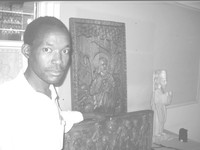Kivuli Boys Lauded at Christian Arts Festival
 Christianity is the largest religion in Kenya, with at least 75% of the country’s population believed to be either Catholics or Protestants.
Christianity is the largest religion in Kenya, with at least 75% of the country’s population believed to be either Catholics or Protestants.
Recently, a movement calling itself Artists for Christ held an ecumenical ‘Festival of Christian Arts in Kenya’ at Tangaza College in Nairobi, where faith-based works of visual and performance art were displayed for four days alongside a series of lectures and discourse with professionals and academicians drawn from the fields of art and theology.
Among the groups invited to participate was the Koinonia Community. Boys from the Kivuli Centre performed a highly acclaimed mime, while a team of artists from the Kivuli Workshops displayed their visual artwork at the festival.
The Kivuli boys performed on the last day of the festival, earning critical acclaim for an outstanding mime titled Simba na Mende (the lion and the cockroach).
The boys’ anticipation was palpable right from the beginning. They arrived way earlier than the other participants and set up base at an outdoor arena while waiting for the day’s events to begin. From their midst, you could hear the gentle tapping of drums, intertwined with the soft clubbing of marimbas and the smooth, melodic fiddling of the ishiriri (African lyre). The result? A somewhat freestyle ensemble, subconsciously composed to sooth their eagerness while complementing the warm Sunday morning sun.
The boys went on stage in the late morning. They played, sang, danced and performed some acrobatic spins before launching into the mime.
Entirely delivered using gestures, facial expressions and body movements, Simba na Mende is a wordless narration of a rivalry between Simba the lion and Mende the cockroach over a chair. Each of the two wants to sit alone on the chair, comfortably and without having to share it with the other.
The mime begins with both Simba and Mende jostling to occupy the entire seating space by displacing the other. Each tries his best, but when none succeeds to dislodge the other, they realize that the only option is share the chair. They agree to sit side by side, even cementing their new “spirit of sharing” with a reluctant embrace to prevent each other from falling off the shared seating space.
The fake smiles on their faces however betray each one’s persisting desire to occupy the entire chair for himself, and a short while later, the two begin fidgeting, each trying to increase their occupied seating area. This renewed commotion causes the chair to drag backwards, symbolizing regression as a result of greed.
According to trainer Job Kihiko, the mime was not designed to carry one predefined meaning, but to allow each audience member draw a unique contextual interpretation.
“We chose miming for two reasons: to break the language barrier, and to suit the message to everyone, be they a child or an adult,” Job explained.
The experts were very impressed by this open-ended symbolism.

“It is like peeling an onion,” scriptwriter Joseph Murungu remarked in his professional analysis, “Simba na Mende teaches children to prefer sharing instead of selfishness, yet adult minds can for instance interprete it in the context of Kenya’s current political situation.”
Murungu went to ahead to explain his allusion to the perennial squabbles in Kenya’s ruling coalition, which was formed by two competing political parties that opposed each other bitterly in a 2007 presidential election and were forced to share power after the contest failed to produce a clear winner.
The brilliant performance earned Job Kihiko a place on the theatre panel during an afternoon question and answer session with the audience. It also drew praise from Comboni priest Pietro Caggiano, who was one of the main coordinators of the festival.
“The performance was mature, in both the art and symbolism of its deeper message,” said Fr. Pietro.
Kivuli Workshops at the Festival

Away from the performances, artists from the Kivuli workshops put their work on display at the visual arts section.
Several exhibition halls had been designated, but the Kivuli artists had brought a large variety of artwork and were assigned their own exhibition room. Among the artists in this room was Edmond Muhinzi, a 45 year old Rwandan sculptor from Kivuli.
Muhinzi came to Kenya as a refugee in 1997 and happened to settle near the Kivuli Centre. Living around artists, he learned to appreciate art and eventually took up sculpting.
His work grew from a hobby into a passion, finally graduating into a way to earn a living. He joined the Kivuli Workshops and polished his artistic skills as the years went by, later becoming able to sustain his family and school his children from his sculpting work.
But now, economic times have changed and selling his art has become much more difficult.
“The world economic crisis has hit us hard,” Muhinzi says, “Fewer tourists are coming to buy souvenirs, and our fellow locals generally say they don’t have the money to splurge on luxuries like artwork.”
One can only hope that the Christian Arts Festival was a chance for him to network for new markets!



